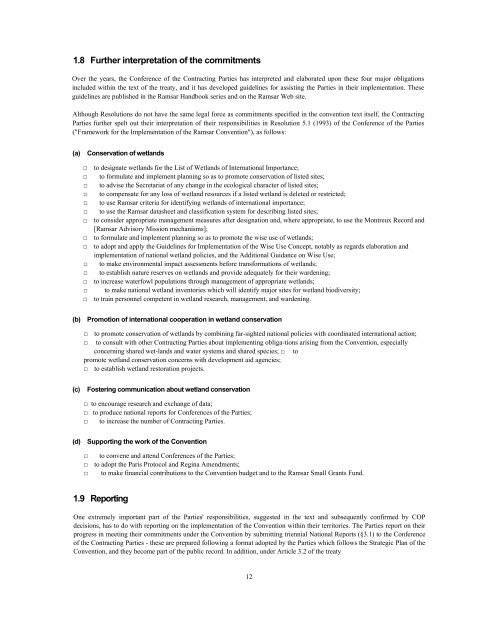The Ramsar Convention Manual.pdf
The Ramsar Convention Manual.pdf
The Ramsar Convention Manual.pdf
You also want an ePaper? Increase the reach of your titles
YUMPU automatically turns print PDFs into web optimized ePapers that Google loves.
1.8 Further interpretation of the commitments<br />
Over the years, the Conference of the Contracting Parties has interpreted and elaborated upon these four major obligations<br />
included within the text of the treaty, and it has developed guidelines for assisting the Parties in their implementation. <strong>The</strong>se<br />
guidelines are published in the <strong>Ramsar</strong> Handbook series and on the <strong>Ramsar</strong> Web site.<br />
Although Resolutions do not have the same legal force as commitments specified in the convention text itself, the Contracting<br />
Parties further spelt out their interpretation of their responsibilities in Resolution 5.1 (1993) of the Conference of the Parties<br />
("Framework for the Implementation of the <strong>Ramsar</strong> <strong>Convention</strong>"), as follows:<br />
(a)<br />
Conservation of wetlands<br />
□ to designate wetlands for the List of Wetlands of International Importance;<br />
□ to formulate and implement planning so as to promote conservation of listed sites;<br />
□ to advise the Secretariat of any change in the ecological character of listed sites;<br />
□ to compensate for any loss of wetland resources if a listed wetland is deleted or restricted;<br />
□ to use <strong>Ramsar</strong> criteria for identifying wetlands of international importance;<br />
□ to use the <strong>Ramsar</strong> datasheet and classification system for describing listed sites;<br />
□ to consider appropriate management measures after designation and, where appropriate, to use the Montreux Record and<br />
[<strong>Ramsar</strong> Advisory Mission mechanisms];<br />
□ to formulate and implement planning so as to promote the wise use of wetlands;<br />
□ to adopt and apply the Guidelines for Implementation of the Wise Use Concept, notably as regards elaboration and<br />
implementation of national wetland policies, and the Additional Guidance on Wise Use;<br />
□ to make environmental impact assessments before transformations of wetlands;<br />
□ to establish nature reserves on wetlands and provide adequately for their wardening;<br />
□ to increase waterfowl populations through management of appropriate wetlands;<br />
□ to make national wetland inventories which will identify major sites for wetland biodiversity;<br />
□ to train personnel competent in wetland research, management, and wardening.<br />
(b) Promotion of international cooperation in wetland conservation<br />
□ to promote conservation of wetlands by combining far-sighted national policies with coordinated international action;<br />
□ to consult with other Contracting Parties about implementing obliga-tions arising from the <strong>Convention</strong>, especially<br />
concerning shared wet-lands and water systems and shared species; □ to<br />
promote wetland conservation concerns with development aid agencies;<br />
□ to establish wetland restoration projects.<br />
(c)<br />
Fostering communication about wetland conservation<br />
□ to encourage research and exchange of data;<br />
□ to produce national reports for Conferences of the Parties;<br />
□ to increase the number of Contracting Parties.<br />
(d) Supporting the work of the <strong>Convention</strong><br />
□ to convene and attend Conferences of the Parties;<br />
□ to adopt the Paris Protocol and Regina Amendments;<br />
□ to make financial contributions to the <strong>Convention</strong> budget and to the <strong>Ramsar</strong> Small Grants Fund.<br />
1.9 Reporting<br />
One extremely important part of the Parties' responsibilities, suggested in the text and subsequently confirmed by COP<br />
decisions, has to do with reporting on the implementation of the <strong>Convention</strong> within their territories. <strong>The</strong> Parties report on their<br />
progress in meeting their commitments under the <strong>Convention</strong> by submitting triennial National Reports (§3.1) to the Conference<br />
of the Contracting Parties - these are prepared following a format adopted by the Parties which follows the Strategic Plan of the<br />
<strong>Convention</strong>, and they become part of the public record. In addition, under Article 3.2 of the treaty<br />
12












